Phases of the Moon and Percent of the Moon Illuminated

Copyright
Antonio Cidadao
. Used by
permission. Click on picture to see large version.
From any location on the Earth, the Moon appears to be a circular
disk which, at any specific time, is illuminated to some degree by
direct sunlight. Like the Earth, the Moon is a sphere which is always
half illuminated by the Sun, but as the Moon orbits the Earth we get to
see more or less of the illuminated half. During each lunar orbit (a
lunar month), we see the Moon's appearance change from not visibly
illuminated through partially illuminated to fully illuminated, then
back through partially illuminated to not illuminated again. Although
this cycle is a continuous process, there are eight distinct, traditionally
recognized stages, called phases. The phases designate both the degree to
which the Moon is illuminated and the geometric appearance of the
illuminated part. These phases of the Moon, in the sequence of their
occurrence (starting from New Moon), are listed below.
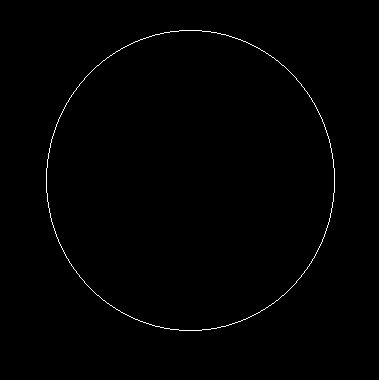
New Moon - The Moon's unilluminated side is facing the Earth. The Moon is
not visible (except during a solar eclipse).
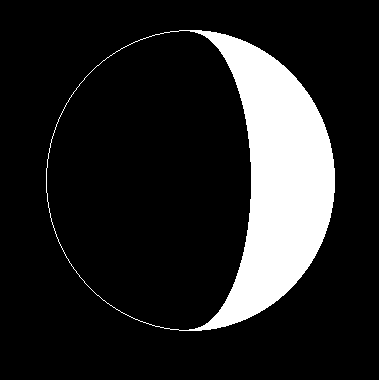
Waxing Crescent - The Moon appears to be partly but less than
one-half illuminated by direct sunlight. The fraction of the Moon's
disk that is illuminated is increasing.
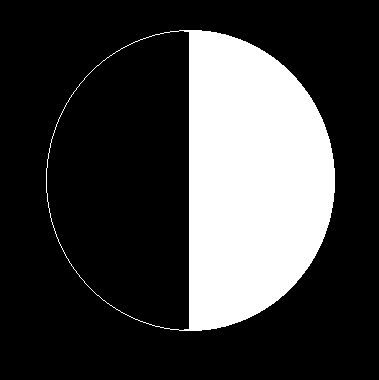
First Quarter - One-half of the Moon appears to be illuminated by
direct sunlight. The fraction of the Moon's disk that is illuminated is
increasing.
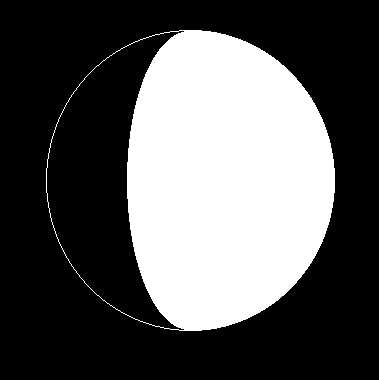
Waxing Gibbous - The Moon appears to be more than one-half but
not fully illuminated by direct sunlight. The fraction of the Moon's
disk that is illuminated is increasing.
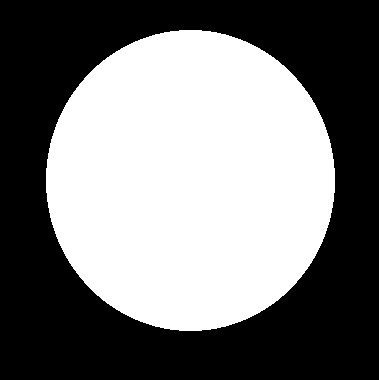
Full Moon - The Moon's illuminated side is facing the Earth. The
Moon appears to be completely illuminated by direct sunlight.
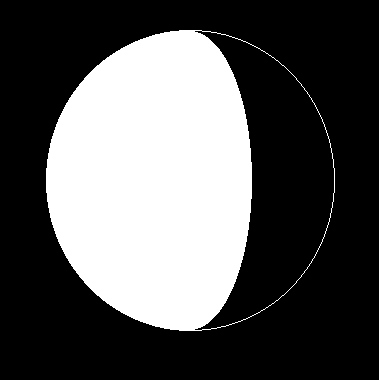
Waning Gibbous - The Moon appears to be more than one-half but
not fully illuminated by direct sunlight. The fraction of the Moon's
disk that is illuminated is decreasing.
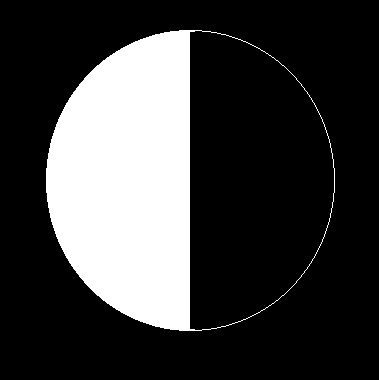
Last Quarter - One-half of the Moon appears to be illuminated by
direct sunlight. The fraction of the Moon's disk that is illuminated is
decreasing.
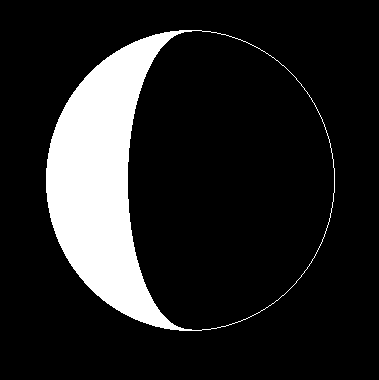
Waning Crescent - The Moon appears to be partly but less than
one-half illuminated by direct sunlight. The fraction of the Moon's
disk that is illuminated is decreasing.
Following waning crescent is New Moon, beginning a repetition of the
complete phase cycle of 29.5 days average duration. The time in days
counted from the time of New Moon is called the Moon's "age". Each
complete cycle of phases is called a "lunation".
Because the cycle of the phases is shorter than most calendar months,
the phase of the Moon at the very beginning of the month usually
repeats at the very end of the month. When there are two Full Moons in
a month (which occurs, on average, every 2.7 years), the second one is
called a "Blue Moon". See the article "Once in a Blue Moon"
for the story of how the usage of this term has evolved
(Ref: Philip Hiscock,
Sky & Telescope
, March 1999, pp. 52-55.).
The first time that the thin waxing crescent Moon is visible after
New Moon (low in the evening sky just after sunset) marks the beginning
of a month in the Islamic Calendar - see the Astronomical Information Center for
Crescent Moon Visibility and the Islamic Calendar.
Although Full Moon occurs each month at a specific date and time, the
Moon's disk may appear to be full for several nights in a row if it is
clear. This is because the percentage of the Moon's disk that appears
illuminated changes very slowly around the time of Full Moon (also
around New Moon, but the Moon is not visible at all then). The Moon may
appear 100% illuminated only on the night closest to the time of exact
Full Moon, but on the night before and night after will appear 97-99%
illuminated; most people would not notice the difference. Even two days
from Full Moon the Moon's disk is 93-97% illuminated.
New Moon, First Quarter, Full Moon, and Last Quarter phases are
considered to be primary phases and their dates and times are published
in almanacs and on calendars. (Click
here for a list.) The two crescent and two gibbous phases are
intermediate phases, each of which lasts for about a week between the
primary phases, during which time the exact fraction of the Moon's disk
that is illuminated gradually changes.
The phases of the Moon are related to (actually, caused by) the
relative positions of the Moon and Sun in the sky. For example, New
Moon occurs when the Sun and Moon are quite close together in the sky.
Full Moon occurs when the Sun and Moon are at nearly opposite positions
in the sky - which is why a Full Moon rises about the time of sunset,
and sets about the time of sunrise, for most places on Earth. First and
Last Quarters occur when the Sun and Moon are about 90 degrees apart in
the sky. In fact, the two "half Moon" phases are called First Quarter
and Last Quarter because they occur when the Moon is, respectively, one-
and three-quarters of the way around the sky (i.e., along its orbit)
from New Moon.
The relationship of the Moon's phase to its angular distance in the
sky from the Sun allows us to establish very exact definitions of when
the primary phases occur, independent of how they appear. Technically,
the phases New Moon, First Quarter, Full Moon, and Last Quarter are
defined to occur when the excess of the apparent ecliptic (celestial)
longitude of the Moon over that of the Sun is 0, 90, 180, and 270
degrees, respectively. These definitions are used when the dates and
times of the phases are computed for almanacs, calendars, etc. Because
the difference between the ecliptic longitudes of the Moon and Sun is a
monotonically and rapidly increasing quantity, the dates and times of
the phases of the Moon computed this way are instantaneous and well
defined.
The percent of the Moon's surface illuminated is a more
refined, quantitative description of the Moon's appearance than is the
phase. Considering the Moon as a circular disk, the ratio of the area
illuminated by direct sunlight to its total area is the fraction of the
Moon's surface illuminated; multiplied by 100, it is the percent
illuminated. At New Moon the percent illuminated is 0; at First and
Last Quarters it is 50%; and at Full Moon it is 100%. During the
crescent phases the percent illuminated is between 0 and 50% and during
gibbous phases it is between 50% and 100%.
For practical purposes, phases of the Moon and the percent
of the Moon illuminated are independent of the location on the
Earth from where the Moon is observed. That is, all the phases
occur at the same time regardless of the observer's position.
Lunation Movie
If you click on either of the two images on the right, you will see
a time-lapse movie of the appearance of the Moon over one lunation. A
lunation is a lunar month, during which time the Moon completely
circles the Earth in its orbit. The complete cycle of phases is
obvious. Two other effects can be easily seen. First, due to the
elliptical shape of the Moon's orbit, the apparent size of the Moon's
disk changes as its distance from Earth varies (the closest and farthest
points do not always occur at the same phases, however). Second,
although the Moon's near side directly faces the Earth on average, we
get to view the Moon from slightly different angles as it orbits us.
This effect, called libration, is caused partly by the tilt of the
Moon's rotation axis with respect to its orbital plane and partly by the
fact that the Moon's speed in its orbit varies but its rotation rate
does not.
The movie is an animated gif created by Antonio Cidadao from a sequence
of still images taken during March and April 1998.
Copyright
Antonio
Cidadao
. Used by permission.
Note: For Moon phase
information specific to a particular date, see
in
Data Services.

